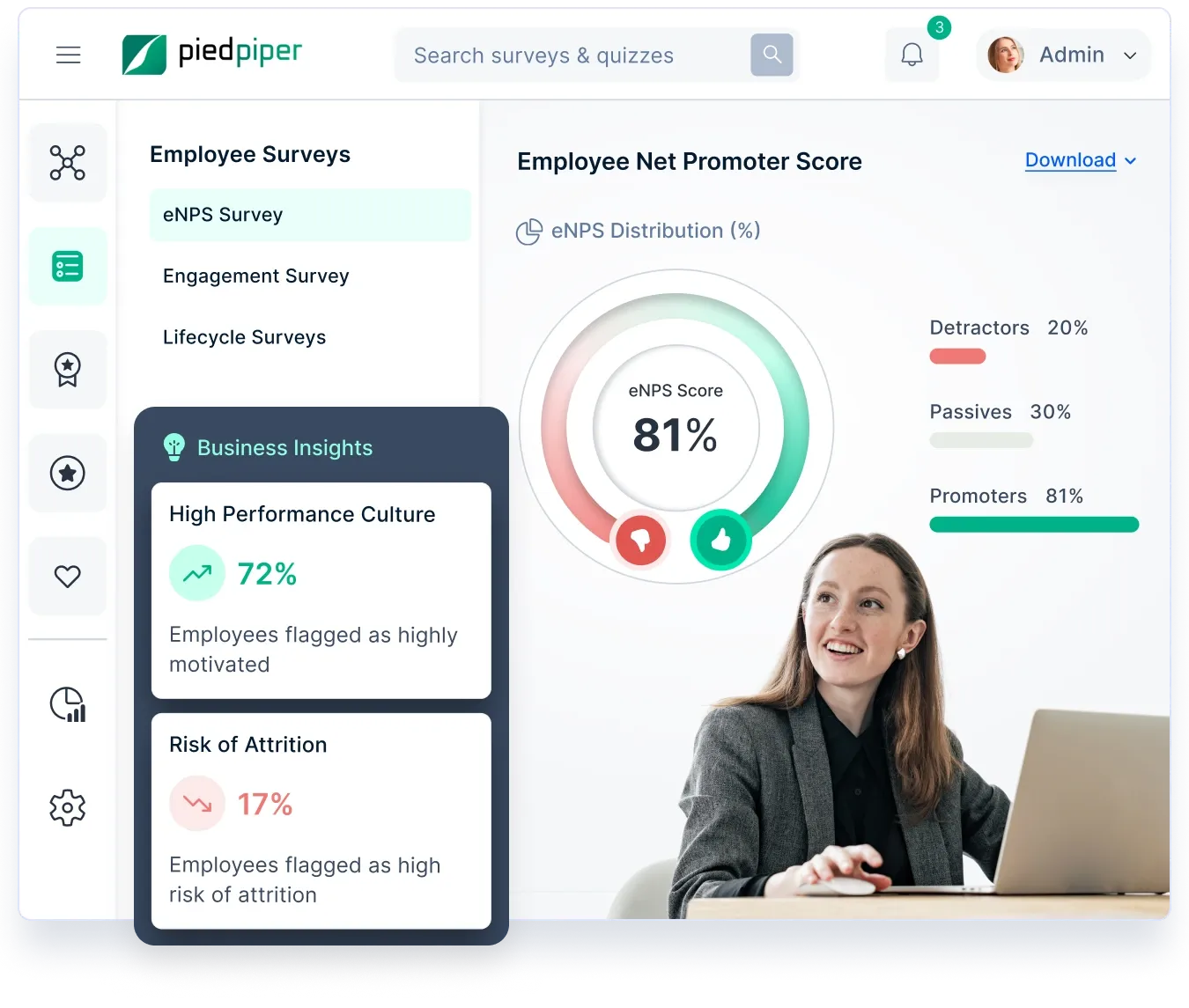Demotivation in the Workplace: Signs, Causes, and How to Motivate a Demotivated Employee
Employee demotivation can impact productivity, morale, and retention. Learn to identify signs of demotivated employees, understand the causes of demotivation in the workplace, and apply effective strategies to motivate a demotivated employee before disengagement spreads.
On this page
Even the most engaged and high-performing teams experience slumps. One moment, your employees are proactive and energized; the next, they’re disengaged, making errors, and struggling to complete routine tasks. This shift isn’t always due to laziness or lack of ability—it's often a sign of employee demotivation creeping in.
Ignoring these warning signs can have serious consequences. A lack of motivation spreads quickly, impacting productivity, morale, and even retention rates. Recognizing the signs of demotivated employees early on is crucial for managers who want to maintain a thriving work environment. From missed deadlines to increased absenteeism, the indicators are often clear—but the root cause isn’t always obvious.
Understanding the causes of demotivation in the workplace is the first step toward reversing it. Whether it’s due to a lack of recognition, unclear expectations, or excessive workload, pinpointing the factors leading to demotivation allows leaders to take meaningful action.
But knowing how to motivate a demotivated employee is what truly makes a difference. With the right strategies, you can re-energize your workforce, rebuild engagement, and create an environment where employees feel valued and driven to perform their best.
10 Signs of demotivated employees in the workplace
Let’s now discuss the prominent symptoms or signs of demotivation in the workplace, which are indeed the characteristics of a demotivated employee in the new normal:
1. Absenteeism or consistent late coming
Has the management trainee who used to pull all-nighters during project deadlines turned out to be a ‘forever stuck in the traffic’ executive? Is the once ‘never absent ever’ executive generating brilliant new reasons to skip work?
A 2012 study derived that the highest positive correlator of ‘conservation of time’ is ‘work mindedness.’ This was amongst the 21 organizational factors presented to 402 employees from across five companies in NCR, Delhi.
The study thus indicates that those punctual people out there - are business drivers, too. Time to carve a plan of employee engagement and motivation if your employees have daily hassles with traffic.
2. Apathetic attitude
Is one of your team members acting the way your partner does when in a bad mood? As if all they want to be is left alone? This is happening even during the increment season when the rest of the team is out with their spectacular selves? Better check this person up.
S. Bishvas’s 2010 study surveyed 357 managers/executives from manufacturing and service sector companies, studied their responses on five factors - psychological climate, job satisfaction, job involvement, turnover intention, and organizational effectiveness – and concluded that there was a high positive influence of psychological stress climate over job satisfaction.
In other words, if there are any indications of psychological stress in an employee - it is also a red flag for the leader.
3. Conflict with peers/ boss
An employee retention study by Iowa State University showed that stayers engaged in more positive behaviors than leavers. Have suddenly the rights become too vast or flexibility too undefined?
Do you feel portrayed like a capitalist every time you fulfill your job responsibilities in team performance management? Time for a reconciliation conference.
4. Constantly stressed/ bored
H J Carla’s study of 700 employees across medium and large-sized agencies in South Carolina indicates that employee engagement is key to retaining today’s workers.
If you know that there is not enough work for any of your team members to be on the desk ALL the time and if this person would not take their regular breaks, it is essential to find out why.
No, they are not having a heated break-up discussion over messages - which you are sympathetic about – they are scoring high in a recently downloaded arcade game over your office Wi-Fi. Better check out their scores!
5. Leads negative discussions
S. Biswas elaborates his observations in a 2010 study. He says:
"The amount of involvement an individual will have with his/her job will depend upon the affirmative strength with which he/she psychologically perceives the various facets of his/her job and job environment."
Thus, when your team member is detected to be increasingly cynical about the company’s sustainability and management initiatives – it is undoubtedly time for a deeper dig.
6. Decrease in productivity and lousy quality of work
Bakotić’s study on 40 large- and medium-sized Croatian companies derived significant correlations between job satisfaction and financial indicators of organizational productivity.
Incomplete reports, erroneous datasheets, and too much idle time are general indicators for an interim review meeting. It could also be for a possible broken spirit– better find out.
7. Withdraws from employee engagement events
Erdila et al's study on 195 employees who worked under a supervisor in İstanbul empirically shows that workplace fun is positively related to engagement and taking charge.
Is the social butterfly now an indoor moth? You either need to re-look at the inclusivity of your employee programs or have a chat with the butterfly.
8. Does not undertake new initiatives
Harte et al, in their study conducted across 36 companies and with 198514 respondents, concluded that employee engagement is related to meaningful business outcomes at a significant magnitude across companies.
Look at that dusty old file titled ‘Methods to maximize efficiencies of the asynchronous processes in congruence with the business process cycle,’ and leave a heavy sigh on how intensive a no pay intern’s projects could be. No initiatives from the same ‘then- interns -now associate? Time up for intense one on ones.
9. Increased activity on professional networking sites
A statistic published by Linkedin tells that out of the 200 million who log in to Linkedin daily, 22 million apply for a job.
Seeing frequent notifications on updates in your team member’s professional page? It also does not seem like a harmless status update but an entire profile relaunch? The high chances are that the 22 Million now has a plus one.
10. Does not responsibly contribute to discussions
Has the ‘can’t-stop-asking-questions’ person turned to a ‘can’t-keep-eyes-open’ person? Herzberg's motivation-hygiene theory famously quotes ‘responsibility, opportunity to do something meaningful’ as prime motivation factors.
The absence of initiative to engage in such opportunities provided by the organization indicates that the person no longer considers it a motivation factor.
Causes of employee demotivation in the workplace
Employee morale, unquestionably, is one of the most vital but most difficult things to manage in a company.
Consistent low morale can be a serious concern for your organization, as unhappy employees lead to higher turnover, poor customer service, and lower productivity.
Therefore, understanding what are the possible factors that are causing low staff morale or low employee motivation can help to fight the challenge head-on.
Here are some of the most common factors that demotivate employees:
1. Lack of professional/personal development

Employees are constantly looking for opportunities to grow in their current role and to be challenged in new ways, with new projects/tasks, etc.
When employees fail to see how their career path is going to progress within the organization, or how they can develop their professional skills while doing what they are doing, it can be extremely dissatisfying.
When workers believe they lack the capacity to carry out a task, they won’t be motivated to do it.
2. Lack of clarity

Nothing demotivates employees/pull the morale down like a lack of clarity. When employees don’t know what is expected out of them or what the organizational objectives are, they end up spending days (sometimes weeks) doing the same task -without any concrete results.
This not only hinders employees from performing to the best of their ability but also demotivates and disengages them. When a task doesn’t connect with or contribute to something workers value, they won’t be motivated to do it.
3. Job Insecurity
Employees who work for unstable companies or in jobs that are insecure will only invest enough to keep getting their paycheck while they look elsewhere. The rest of their energy will be spent sharing rumors with co-workers, updating their resumes, and planning their next move.
The best you can do is to communicate frequently and give your team a sense of loyalty and trust. You should figure out why employees are feeling about job security and mitigate those reasons. High attrition rates can lead to cascading morale issues across the organization.
4. Lack of communication

Lack of communication is one of the most challenging employee demotivation factors. Change can be overwhelming and difficult to cope with.
Be it change in leadership, work environment, team structure, etc., or a sudden switch to working from home (in a situation like that of the most recent COVID-19 pandemic), change can be extremely challenging.
When this is accompanied by a lack of communication, it only leads to further confusion, ambiguity, and decreased engagement.
5. Lack of workplace flexibility
While most of your employees understand that workloads can go up and down, requiring a member of your staff to keep up with unreasonable workload for long periods of time can result in burnout and resentment.
Also, if your company policies are so stringent that it's making the work more complex and tough for your employees rather than helping them succeed at work, then such policies do more harm than good.
If the work stress and burnout lead to health issues with employees, it'll definitely lead to employee demotivation.
6. Feeling invisible in the workplace

People want to be appreciated for their efforts and dedication. When managers fail to recognize the hard work and dedication of their employees, it often leads to employees feeling invisible within the organization – further leading to loss of self-esteem, low employee morale, and disengagement.
7. Failing to address company mission, vision & values
If there are consistent issues around some policies related to a department or gender or location and such issues are not being addressed, then there are high chances that employees will start getting demotivated to work with the company.
They feel insecure and start having lower confidence in the management. These issues can be related to any public misinformation, any firing, any gender bias, sexual harassment, race bias, and so on.
If the company is not investigating or acting on a matter of grave misconduct, then employee morale can go wrong.
8. Lack of trust or micromanagement

Managers often tend to get into micromanagement of their team members’ work when they don’t trust them enough.
They tend to get involved in every step of the project execution, telling their employees what to do, how to do it, and at times sitting with them to get it done their way.
It’s frustrating, demoralizing, and demotivating. People expect a certain level of freedom and authority to make their own decisions within the limitations of their job roles.
How to motivate a demotivated employee: 6 Most effective ways
Here are six effective ways to motivate a demotivated employee while addressing employee demotivation and the demotivating factors that might be causing it.
1. Identify and address demotivating factors
The first step in understanding how to motivate a demotivated employee is identifying what’s causing their disengagement. Employee demotivation can stem from several demotivating factors, such as unclear job expectations, lack of recognition, stagnant career growth, or a toxic work environment.
Conducting one-on-one meetings, gathering feedback through anonymous surveys, or having open discussions can help uncover these underlying issues. Once identified, take corrective actions like clarifying job roles, improving team dynamics, or addressing workload concerns. Employees feel valued when they know their concerns are heard and actively addressed.
2. Provide meaningful recognition and appreciation
A major demotivating factor is feeling unappreciated. Employees who don’t receive recognition for their hard work often lose interest and engagement. A simple ‘thank you’ or acknowledging their contributions in team meetings can uplift their spirits. However, recognition should be structured and meaningful rather than just an occasional appreciation.
Platforms like Empuls offer a seamless way to implement an effective rewards and recognition system. Organizations can appreciate employees through peer-to-peer recognition, milestone rewards, and performance-based incentives. Integrating such tools can create a culture where employees feel valued, boosting motivation and workplace morale.
3. Offer opportunities for growth and development
Employees who see no career progression or skill development in their role are likely to experience employee demotivation. The absence of learning opportunities and stagnant roles can make them disengaged.
Providing skill-building workshops, mentorship programs, and clear career growth paths can reignite their enthusiasm. Assigning them to meaningful projects that challenge their skills or sponsoring professional development courses can also make a difference. Employees who see a future in the organization stay more committed and driven.
4. Improve work-life balance and reduce stress
Burnout and excessive workload are among the most common demotivating factors. When employees feel overworked without sufficient breaks or flexibility, their productivity and motivation suffer.
Encourage a healthy work-life balance by offering remote work options, flexible schedules, or wellness initiatives. Simple changes like allowing mental health days, reducing unnecessary meetings, and promoting a supportive work environment can lead to significant improvements in motivation. Employees who feel their well-being is prioritized are more engaged and committed to their work.
5. Set clear goals and provide autonomy
Unclear expectations and micromanagement often contribute to employee demotivation. Employees need to understand their role, what’s expected of them, and how their contributions impact the bigger picture. Without clear direction, they may feel lost or undervalued.
Set measurable and achievable goals while allowing employees to execute tasks their way. Avoid constant supervision—trusting employees with responsibilities fosters confidence and motivation. When they have ownership over their work, they feel more accountable and invested in their tasks.
6. Conduct employee surveys and act on feedback
Understanding how to motivate a demotivated employee requires continuous feedback. Conducting employee surveys helps in identifying demotivating factors that might be causing disengagement. However, collecting feedback is just the first step—acting on it is what truly makes a difference.
Empuls offers an advanced employee survey tool that helps organizations track engagement levels, collect honest feedback, and implement necessary changes.
Regular pulse surveys, engagement check-ins, and satisfaction assessments allow HR teams to address workplace concerns before they escalate. When employees see that their input leads to real improvements, they feel more valued and motivated.
Organizations can create an engaging and rewarding work environment by addressing demotivating factors and implementing structured ways to motivate a demotivated employee. Investing in recognition, career development, work-life balance, autonomy, and employee feedback leads to long-term motivation and retention.
Reignite employee motivation with Empuls
Demotivation doesn’t happen overnight. It creeps in when employees feel unheard, unappreciated, or disconnected from their work. A lack of recognition, unclear communication, and an uninspiring workplace culture can quickly lead to disengagement and lower productivity. Empuls helps businesses turn this around by creating an environment where employees feel valued, motivated, and excited to contribute.
Uncover the root causes of demotivation

Employee disengagement isn’t always obvious. Some might struggle with unclear goals, while others feel their contributions go unnoticed. Empuls’ Employee Survey Tool gives employees a voice by collecting real-time feedback. By analyzing engagement trends and pinpointing concerns, organizations can take proactive steps to address workplace frustrations and create a culture where employees feel heard and supported.
Recognize and reward achievements to boost morale

Employees thrive when their hard work is acknowledged. Empuls' Rewards & Recognition platform makes appreciation a seamless part of workplace culture by enabling peer-to-peer recognition, instant rewards, and leadership-driven appreciation. Whether it’s a simple shoutout, a tangible reward, or a structured incentive program, recognition fuels motivation and helps employees stay engaged.
Make milestones meaningful
Celebrating professional milestones isn’t just about acknowledging tenure—it’s about reinforcing commitment and loyalty. Empuls’ Milestone Rewards ensures that every work anniversary, project completion, or performance achievement feels special with personalized rewards and heartfelt appreciation. Employees who feel valued for their long-term contributions remain motivated to stay and grow with the organization.
Create a thriving company culture

A workplace culture that fosters inclusivity, collaboration, and recognition is a powerful antidote to demotivation. Empuls’ Company Culture Software helps build a strong foundation by creating a space where employees can connect, share ideas, and engage in meaningful discussions. A positive culture transforms workplaces from transactional environments into spaces where employees feel inspired and invested in their roles.
Strengthen communication and workplace connections

Poor communication can quickly lead to disengagement, leaving employees feeling isolated and uninformed. Empuls’ Social Intranet acts as a dynamic communication hub where teams can stay updated, participate in discussions, and build a sense of community.
From leadership announcements to team-wide conversations, it ensures that employees feel connected, valued, and part of something bigger.
Demotivation thrives in environments where employees feel overlooked, but Empuls turns disengagement into enthusiasm, fostering a workplace where every individual feels recognized, empowered, and connected.
Conclusion
Employee demotivation isn’t just an individual problem—it affects team dynamics, productivity, and overall workplace culture. Ignoring the signs of demotivated employees can lead to disengagement spreading across the organization, making it harder to recover.
By identifying the causes of demotivation in the workplace, whether it's lack of recognition, unclear goals, or poor work-life balance, leaders can take proactive steps to address the issue. Creating a supportive environment, offering growth opportunities, and using tools like Empuls for recognition and feedback can make a significant difference.
Motivating employees isn’t about quick fixes—it’s about fostering a workplace where people feel valued, heard, and empowered. When businesses invest in their employees' well-being and motivation, they build a culture of engagement, loyalty, and long-term success.


















